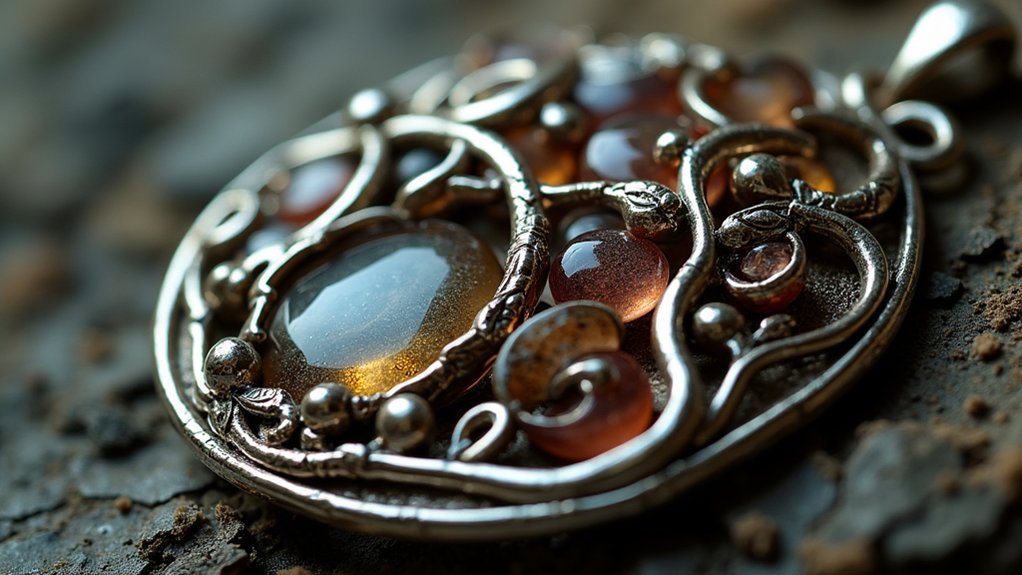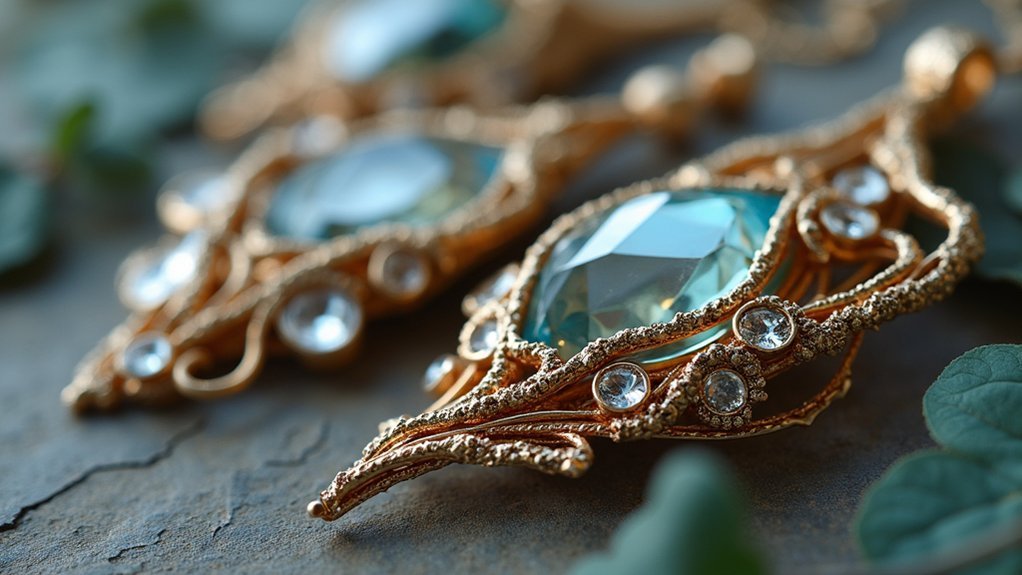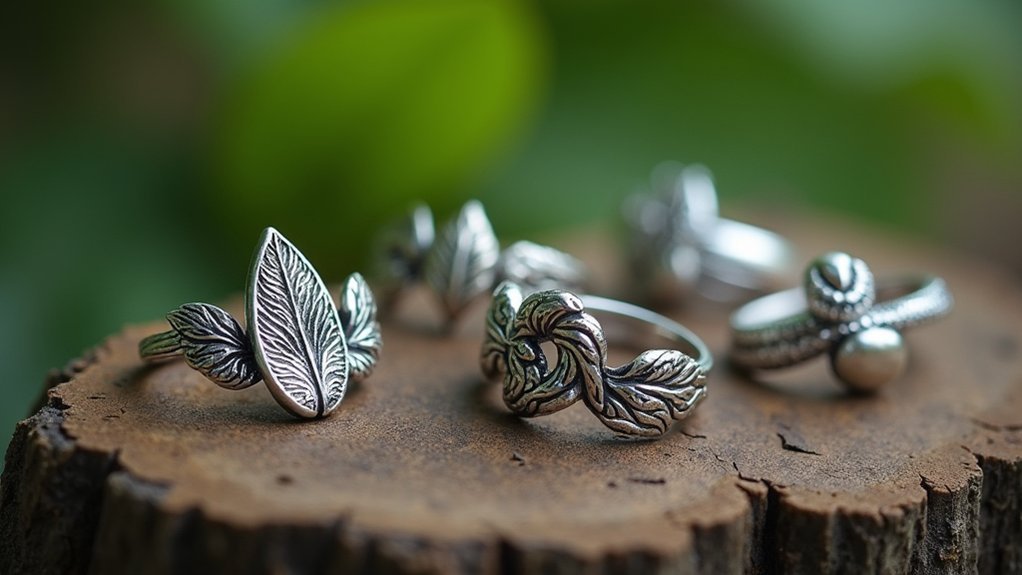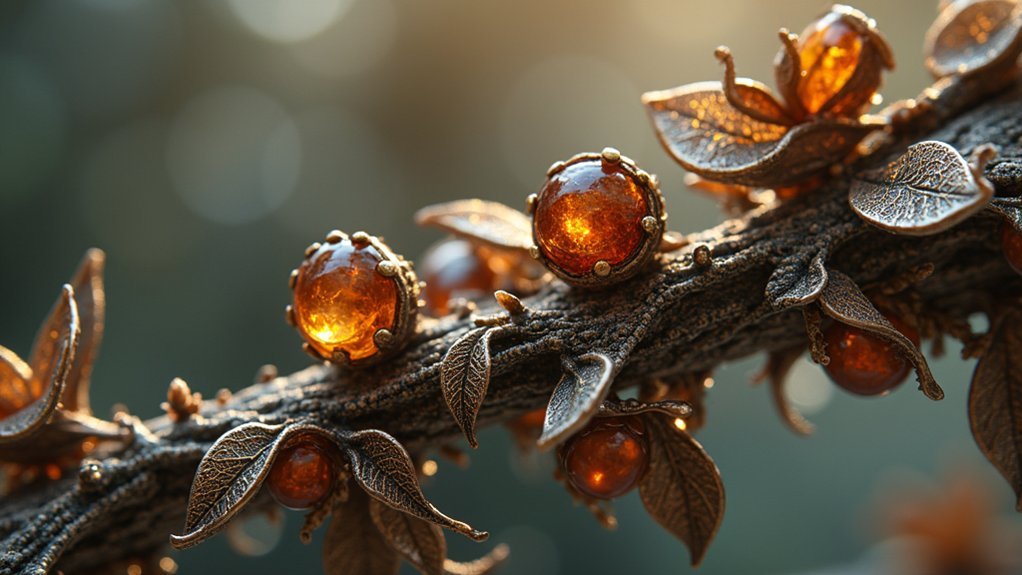Organic forms in jewelry design draw inspiration from nature’s flowing curves, irregular textures, and asymmetrical patterns found in elements like leaves, flowers, shells, and coral. You’ll notice these pieces break away from traditional geometric symmetry, instead celebrating the spontaneous beauty and unique irregularities of the natural world. Designers use techniques like casting and electroforming to capture intricate details from organic materials, creating abstract interpretations that connect your personal style with nature’s inherent artistry and establish a deeper appreciation for the organic world around you.
Defining Organic Forms and Natural Inspiration in Jewelry

When you observe a piece of jewelry that captures the flowing curve of a vine or the delicate ridges of a seashell, you’re witnessing organic forms in design—irregular, asymmetrical shapes that mirror nature’s own artistry.
These Organic Shapes in Jewelry Design draw directly from your natural environment, transforming leaves, flowers, and shells into wearable art that celebrates the living world’s inherent beauty.
You’ll find that designers don’t limit themselves to literal representations. They often create abstract interpretations that capture nature’s essence through fluid, irregular patterns.
Whether you’re wearing a pendant Inspired by Nature’s textures or rings incorporating natural materials, these pieces establish a meaningful connection between your personal style and the organic world around you.
Key Characteristics of Organic Shape Design Elements
When you examine organic jewelry design, you’ll notice how pieces draw inspiration from nature’s endless variety of forms, from the spiraling patterns of nautilus shells to the branching structures of coral reefs.
You’ll find that asymmetrical design patterns become the hallmark of these creations, deliberately breaking away from traditional symmetrical arrangements to capture nature’s inherent irregularity.
You’ll discover that these intentionally unbalanced compositions create visual interest and movement that mirrors the organic world’s spontaneous beauty.
Natural Shape Inspiration Sources
Nature’s endless variety provides jewelry designers with an inexhaustible wellspring of organic forms, from the delicate spiral of a nautilus shell to the intricate branching patterns of coral reefs.
You’ll find that leaves, flowers, and shells serve as primary inspiration sources for creating natural shapes in organic jewelry. These elements offer designers authentic blueprints for unique designs that capture nature’s inherent asymmetry and fluidity.
When you examine botanical forms like vine tendrils or tree bark textures, you’re witnessing the raw materials that translate into stunning jewelry pieces.
Marine life provides equally rich inspiration—sea fans, kelp formations, and mollusk shells all contribute distinctive patterns. This direct connection to nature guarantees your organic jewelry maintains authenticity while celebrating the irregular beauty found throughout the natural world.
Asymmetrical Design Patterns
Unlike traditional jewelry that relies on perfect symmetry and geometric precision, asymmetrical design patterns embrace nature’s inherent irregularities to create pieces that feel alive and spontaneous.
You’ll find these organic shapes incorporate flowing lines, varying textures, and irregular forms that mirror leaves, waves, and stone contours from the natural world.
These patterns challenge conventional geometric designs by distributing visual weight unevenly, creating relaxed, artistic aesthetics.
You’ll discover that asymmetry allows jewelers to craft truly unique designs where no two pieces are identical—just like nature itself. The fluid, unpredictable elements generate dynamic movement and visual interest that makes each piece stand out.
When you choose asymmetrical organic jewelry, you’re embracing individuality and free-spirited creativity over traditional uniformity.
Materials and Techniques for Creating Flowing Natural Forms

Since natural forms possess inherent irregularities and flowing movements, creating jewelry that captures their essence requires careful selection of both materials and techniques. You’ll find that precious metals like gold and silver serve as ideal foundations, while natural stones add authentic textures and colors.
| Materials | Techniques |
|---|---|
| Gold, Silver | Casting |
| Natural Stones | Electroforming |
| Recycled Metals | Handcrafting |
| Ethically Sourced Gems | Texture Replication |
Advanced techniques like casting allow you to replicate intricate details from real organic materials. Electroforming lets you coat delicate natural objects with metal, preserving their original shapes while creating durable pieces. You can employ handcrafting methods to achieve flowing, asymmetrical designs that mirror nature’s irregularities. Embracing sustainable practices through recycled metals and ethically sourced gemstones aligns with organic philosophy while enabling unique designs.
Popular Organic Motifs: Leaves, Flowers, and Abstract Nature
You’ll find that leaf-inspired elements form the backbone of organic jewelry design, where casting techniques capture every vein and natural texture directly from real foliage.
Floral patterns offer endless creative possibilities through layered petal structures that mirror nature’s own architectural beauty.
These motifs let you translate botanical forms into wearable art that celebrates both craftsmanship and environmental awareness.
Leaf-Inspired Design Elements
When you’re drawn to jewelry that captures nature’s essence, leaf-inspired design elements offer an authentic connection to the organic world around you.
These unique designs showcase intricate patterns and structures that evoke growth and renewal, making each piece deeply meaningful.
You’ll find leaf-inspired jewelry ranging from literal representations to abstract interpretations, giving you countless creative options.
Casting techniques preserve real leaves’ authentic textures and shapes, creating natural details you can’t replicate artificially.
When combined with sustainable materials like ethically-sourced gold and gemstones, these organic motifs enhance both aesthetic appeal and environmental responsibility.
Floral Pattern Applications
Three primary approaches define how floral patterns transform into stunning jewelry pieces: literal botanical reproductions, stylized interpretations, and completely abstract nature forms.
You’ll find designers using casting and engraving techniques to capture authentic textures and shapes from real plants, creating jewelry that mirrors nature’s intricate details. These floral patterns showcase leaves and flowers as prominent motifs, symbolizing growth and environmental appreciation.
When you choose abstract representations, you’re embracing creativity and innovation that results in unique designs resonating with organic themes.
Designers enhance natural beauty by incorporating diverse color palettes inspired by the natural world, giving your jewelry pieces an authentic organic feel that celebrates nature’s complexity and elegance.
Craftsmanship Methods for Capturing Natural Textures

While traditional metalworking forms the foundation of jewelry making, capturing nature’s intricate textures requires specialized techniques that bridge the gap between organic beauty and wearable art.
The craftsmanship behind these production methods involves casting techniques that preserve authentic details of real organic materials.
You’ll discover that electroforming coats delicate natural items with metal, maintaining fine textures while enhancing durability.
Engraving and etching methods help you mimic natural patterns found in organic elements for realistic metal representations.
You can use natural forms as templates to replicate unique textures, ensuring each piece reflects its inspiration’s characteristics.
Workshops provide hands-on experiences where you’ll explore various materials and techniques to create unique jewelry designs incorporating natural textures.
Styling Guidelines for Wearing Organic Form Jewelry
Since organic form jewelry draws its appeal from nature’s inherent asymmetry and flowing lines, you’ll find these pieces offer remarkable versatility in your styling choices.
These designs work beautifully with both casual and festive attire, adapting to various occasions effortlessly.
When incorporating organic jewelry into your wardrobe, consider these essential styling tips:
- Combine similar shapes – Pair pieces with complementary organic forms or simple designs to maintain visual balance
- Embrace layering – Use smooth-textured necklaces and bracelets as standalone statements or layer them for added depth
- Match natural palettes – Choose colors that reflect the jewelry’s natural inspiration to create cohesive, harmonious looks
The dynamic curvature of organic earrings and rings creates movement, drawing attention while adding unique focal points to your ensemble.
Sustainability and Ethical Sourcing in Nature-Inspired Pieces

As you explore nature-inspired jewelry, you’ll discover that today’s organic designs increasingly reflect a deeper commitment to environmental stewardship and ethical practices.
When you choose organic jewelry design, you’re supporting creators who prioritize ethically sourced materials like recycled metals and conflict-free gemstones. These environmentally conscious designers implement eco-friendly production methods that minimize carbon footprints while maintaining aesthetic appeal.
You’ll find certifications such as Fairtrade Gold and Fairmined Gold serve as essential indicators of responsible sourcing practices.
Current Trends and Future Directions in Organic Jewelry Design
Today’s organic jewelry designers are pushing creative boundaries by embracing natural shapes and textures that mirror the intricate beauty of leaves, flowers, and other botanical elements.
You’ll find these artisans utilizing advanced techniques like electroforming and casting to preserve nature’s delicate details, creating pieces that celebrate sustainability while delivering unique design aesthetics.
Current trends you’re seeing include:
Enhanced focus on ethically sourced materials and eco-friendly production methods driving today’s organic jewelry innovation forward.
- Enhanced focus on ethically sourced materials and eco-friendly production methods
- Integration of movement and dynamic elements for interactive jewelry experiences
- Strategic social media marketing on platforms like Instagram to reach environmentally conscious consumers
Future directions promise even more innovation as designers blend traditional organic jewelry concepts with contemporary technology.
You’ll witness pieces that don’t just replicate natural shapes but actually incorporate functional movement, making each creation both visually stunning and engaging to wear.
Frequently Asked Questions
What Are Organic Forms in Design?
You’ll find organic forms in design feature irregular, fluid shapes that mimic nature’s patterns. They’re characterized by asymmetrical, free-flowing aesthetics inspired by leaves, shells, and natural phenomena, contrasting sharply with rigid geometric designs.
What Are the Three Main Types of Jewelry?
You’ll find three main jewelry types: fine jewelry made from precious metals and gemstones, fashion jewelry using less expensive materials for trends, and costume jewelry incorporating non-precious materials for specific outfits.
What Are Organic Shapes and Their Meanings?
You’ll find organic shapes are free-flowing, asymmetrical forms inspired by nature like leaves, flowers, and shells. They represent movement, growth, and life’s natural beauty, creating unique pieces that celebrate diversity and environmental harmony.
What Is an Organic Shape in Interior Design?
You’ll find organic shapes in interior design are nature-inspired forms with fluid, irregular lines that create harmony in your space. They’re asymmetrical structures that’ll make your rooms feel more relaxed and inviting.
In Summary
You’ll find that organic forms in jewelry design offer endless possibilities for expressing your personal style while honoring nature’s beauty. Whether you’re drawn to delicate leaf motifs or bold abstract shapes, these pieces connect you to the natural world. As you explore this design philosophy, you’ll discover that organic jewelry isn’t just about aesthetics—it’s about embracing sustainability, craftsmanship, and the timeless appeal of nature’s own artistry.





Leave a Reply